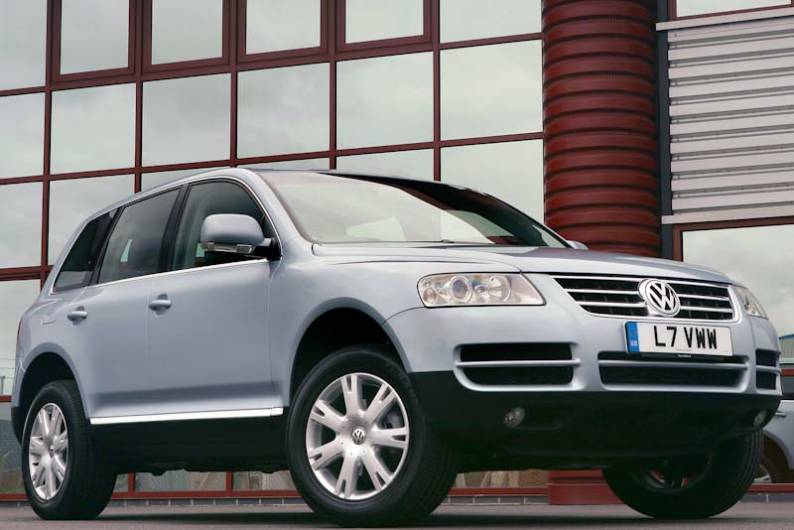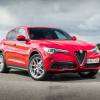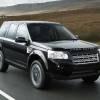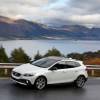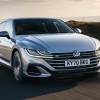
RAC sale – up to 33% off*
• Roadside cover from £5.29 a month†
• We get to most breakdowns in 60 mins or less
• Our patrols fix 4/5 breakdowns on the spot

BY ANDY ENRIGHT
Introduction
The Touareg is a car that Volkswagen couldn't afford not to build. Missing out on a huge slug of the burgeoning American 'Sports Utility' market didn't sit happily with the top brass at Volkswagen and sharing a good deal of the chassis development budget with Porsche also helped to defray spiralling costs. The result is a car that many feel is better looking than its Porsche cousin, the Cayenne, and which also features a wide range of powerplants. A used Touareg may not be the obvious choice but it's certainly one of the best big bruisers.
Models
Models Covered:
(5dr luxury 4x4, 3.2, 3.6, 4.2 petrol, 2.5, 3.0, 5.0 diesel / standard, SE, Sport, Altitude, R50, BlueMotion)
History
The Touareg is full of surprises. First off is the name, a version of the African Toureg tribe (literally 'Free Folk') that somehow gained an extraneous 'a'. Manufactured in Bratislava in Slovakia, the Touareg and the Porsche Cayenne share the same chassis, transmission, AWD system, suspension, windshield, doors, and some sheet metal. Although the two vehicles were largely co-developed, Porsche and Volkswagen parted company two years before the introduction of the pair to work in secret on the remaining aspects of the cars. As a result, the Volkswagen is the more accomplished off road whereas the Porsche, somewhat unsurprisingly, holds an edge on the blacktop.
First shown at the Paris Motor Show in September 2002, the Touareg arrived in dealer's showrooms very quickly thereafter, being available in Germany in December 2002 and landing here in the UK in early May 2003. No fewer than four engines were offered; 3.2 and 4.2-litre petrol versions and 2.5 and 5.0-litre TDI diesels. A 3.0-litre V6 TDI engine was added in the autumn of 2004.
The imminent arrival of Audi's Q7 in the Summer of 2006 presented Volkswagen with a big problem. The Touareg was going to impinge directly on the Audi's territory and action had to be taken to avoid the two stablemates scuppering each-other's chances. So it was that the Touareg range was revised in Spring 2006 with prices cut by over £2,000. The trim range became standard, SE and Altitude with the latter model offering real road presence via some massive alloys and bodystyling features. The big V8 petrol engine was replaced by a 3.6-litre V6 FSI unit at the same time.
The 2007 model year facelift brought the H-shaped chrome grille to the Touareg's nose pulling it in line with the growing band of other Volkswagen products to sport this styling treatment. Revised wing mirrors and light clusters also featured as did a collection of technological innovations, most of them optional. One that was standard is the ABSPlus braking system which can cut braking distances by 20 per cent on muddy surfaces.
The range-topping R50 version was launched in early 2008 with a 345bhp version of the V10 TDI engine. Then the 3.0 V6 got a power boost to 237bhp and a BlueMotion model was introduced in mid 2009. Using a 222bhp version of that engine and some other modifications, it achieved 34mpg, not bad for a luxury 4x4.
What You Get
The philosophy behind the Touareg was to offer three vehicles in one with an eye on the lucrative US market. In a category dominated by the Mercedes M-class, the BMW X5 and the Range Rover, the Touareg needed to be something special.
So what's the car like? In a word, big. At 170cm high it's not lacking in road presence. The range-topping V10 TDI sits a couple of centimetres higher still on its air suspension, the other models relying on more conventional steel springs. Unless, that is, you want to hit the options list. The interior styling is pleasantly restrained, the materials quality is class leading and the look and feel is much like the opulent Phaeton. Standard equipment includes electronic climate control, a multifunction computer, ten-speaker CD system, walnut trim, heated and folding door mirrors and a huge airbag count.
The 2.5TDI and the V6 models wear a slightly overwhelmed set of 17-inch alloy wheels. Move up to the V8 and there are features such as leather trim, dusk-sensing lights, heated seats, engine compartment lights and chrome finishing on the doors and grille. The V10 TDI is where things again go off the chart. This adds Continuous Damping Control Air Suspension, bi-Xenon lights, remote engine start, memory for your seat belt height, steering column, mirrors and seats and a stereo system with no fewer than eleven speakers. It can be recognised from the outside by its 18-inch wheels, a chrome air intake and front fog lights. And a little badge on the back. The Altitude trim level provided massive 20-inch alloys to go with its bodykit.
What You Pay
Please fill in the form here for an exact up-to-date information.
What to Look For
The Touareg uses largely tried and tested mechanicals and there have yet to be any major faults. There was a recall to fix a fault with the tyre pressure monitoring system but this had no effect on safety. Touareg owners have reported that getting locked out of your vehicle is a distinct possibility. Here's how to do it. First, exit the vehicle and lock it. Next, approach the rear of the vehicle and open the glass hatch. The glass hatch will only open if your key is within a few feet of the back of the vehicle. Once the rear glass hatch is open, place your jacket with the Touareg key in its pocket inside the Touareg. Close the rear hatch. After a few seconds, the Touareg will re-lock the rear hatch, thus locking your key in the car. One to remember if you don't want to make an embarrassing call to the fourth emergency service.
Many used Touaregs have cracks near the bottom of the driver's seat. This is caused by an attempt to get to the vehicle's battery, which is found beneath the driver's seat and for which access requires removal of the driver's seat and surrounding facia.
Replacement Parts
(approx based on a 2003 3.2 V6) Volkswagen parts used to have a reputation for costliness, but by and large that's now unfounded. The Touareg, however, is a big, powerful vehicle and as such parts are often heavy duty items with corresponding prices. A clutch assembly retails at around £335, front brake pads are £75 a pair whilst rears are £45 a set. Brake discs retail at £76 for front units with rear units costing £63. An alternator with belt is just over £290 and a headlamp is £192. A starter motor is just over £100.
On the Road
On the road, the Touareg can't quite back up Volkswagen's optimistic claim to be better than a BMW X5. It comes close and is a little tauter than a Range Rover and a whole lot keener than a Mercedes M-class. The Volkswagen has slightly more lateral roll in corners and there's that bit more side to side 'wobbly head syndrome' that BMW has worked so hard to exorcise. The V10 TDI is monstrously muscular, despatching the sprint to 60mph in 7.6 seconds yet will return an average of 23mpg - a decent return for a car that tips the scales at around 2,500kg. The V6 and V8 petrol models are respectably quick, although neither can match the diesels' parsimony. The 3.0-litre V6 TDI diesel which was added to the range later is a more modern proposition than either the V10 or the 2.5-litre 5-cylinder unit, this is manifested in greater refinement and improved emissions.
It's off road that the Touareg plays its trump card, especially when equipped with air suspension. Permanent four wheel drive and a low ratio gearbox are taken for granted, but factor in selectable front and rear differential locks, hill start and descent assist and very short front and rear overhangs and the Touareg becomes an awesomely capable tool. With low range engaged, the Touareg can drag itself up a 45-degree slope with 35 degrees of sideways lean. The V10's torque is always a bonus, but the light weight of the smaller diesels, the V6 and the V8 engines make them particular nimble on downhill stretches.
Overall
Although at this price point there are a number of competing attractions for your money, the Touareg is perhaps the best compromise of the lot. It's not as sporty as a BMW X5 or a Porsche Cayenne, not quite so family friendly as a Volvo XC90 and doesn't have the badge equity of a Range Rover. What it does do is cover all of these bases acceptably well while at the same time offering one of the best off-road performances of any of the super-luxury 4x4s. If you can step back and see the big picture, the Touareg makes a lot of sense. With used examples now starting to appear in meaningful numbers, we'd recommend any of the diesel models.

